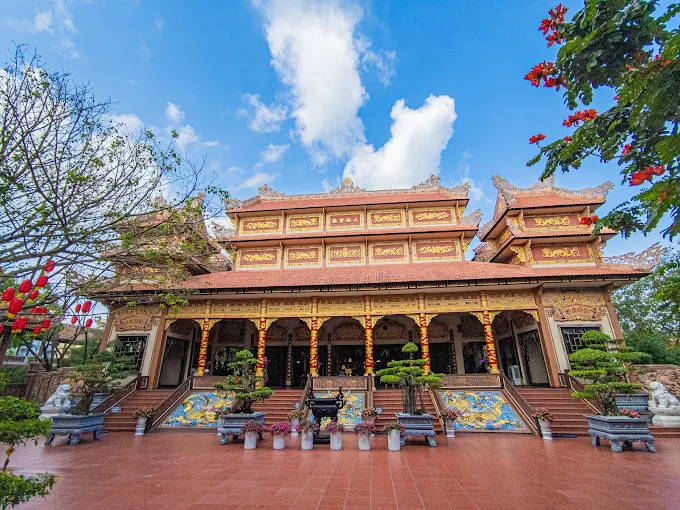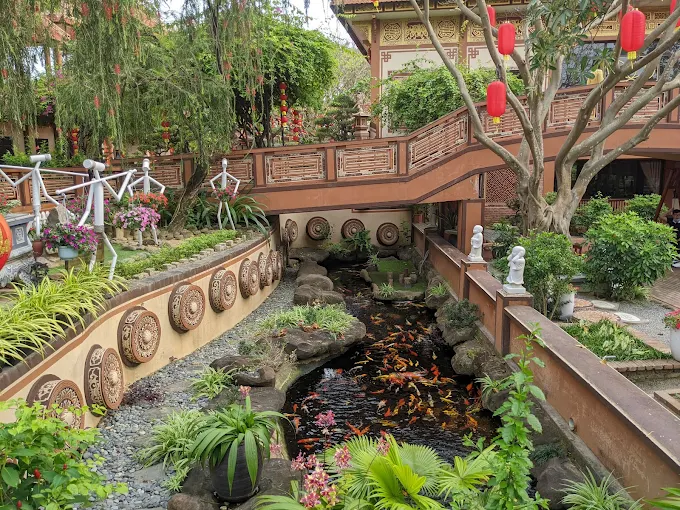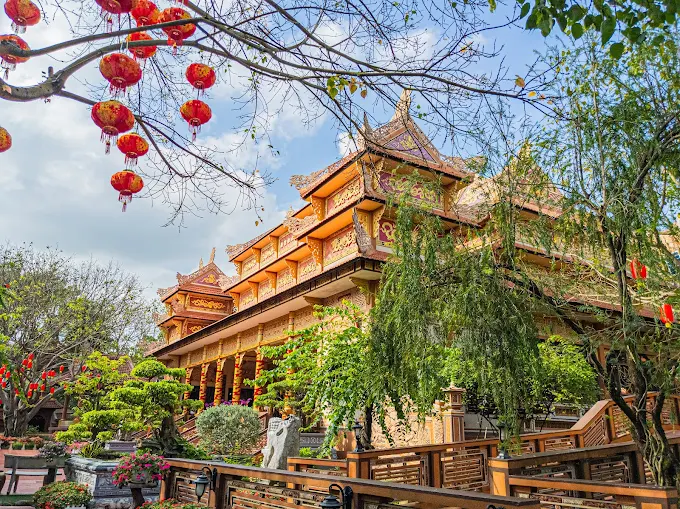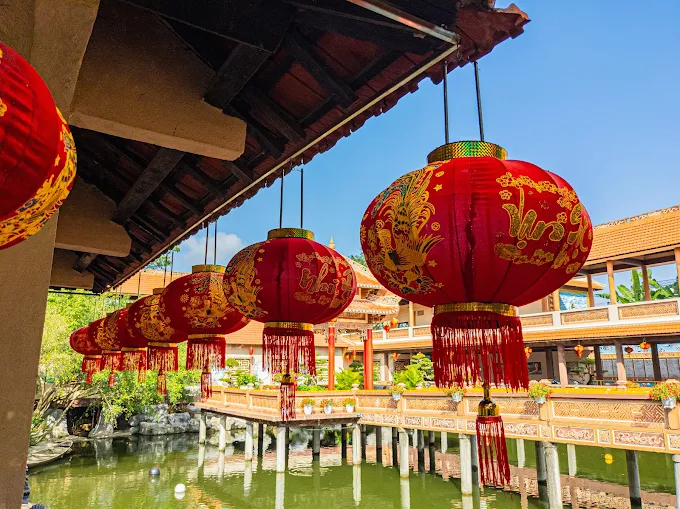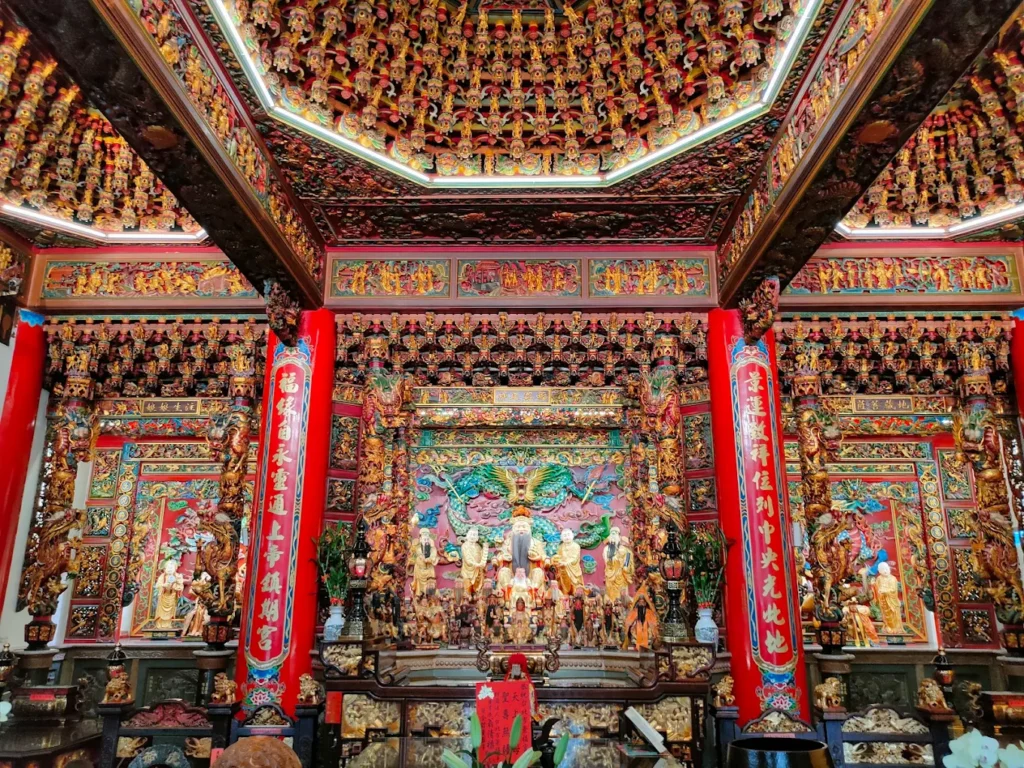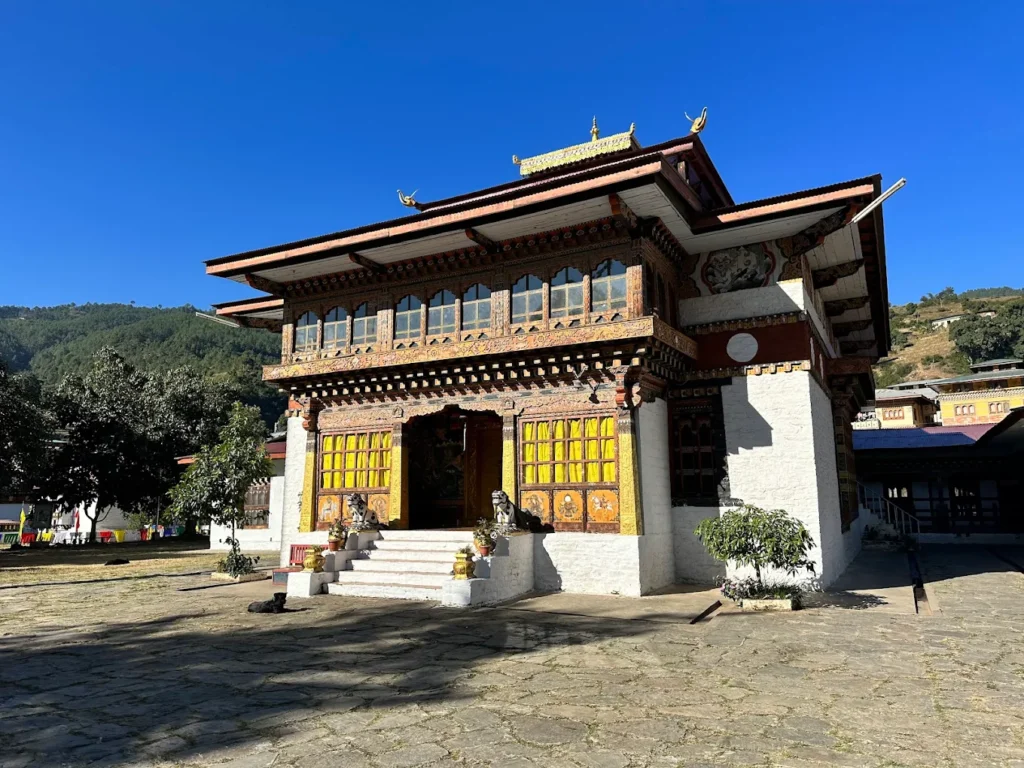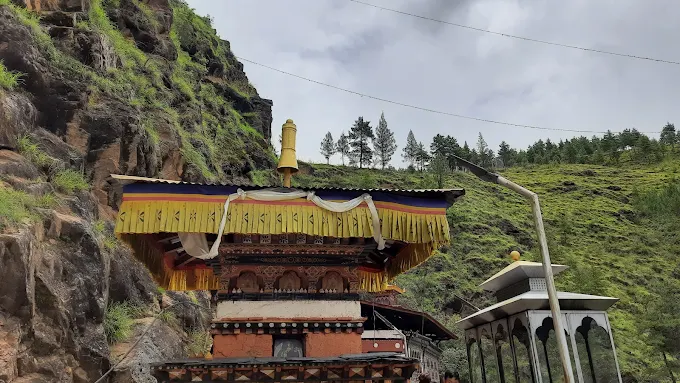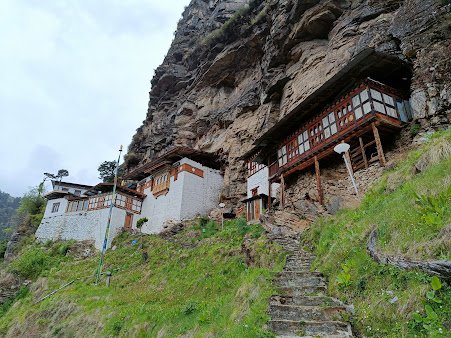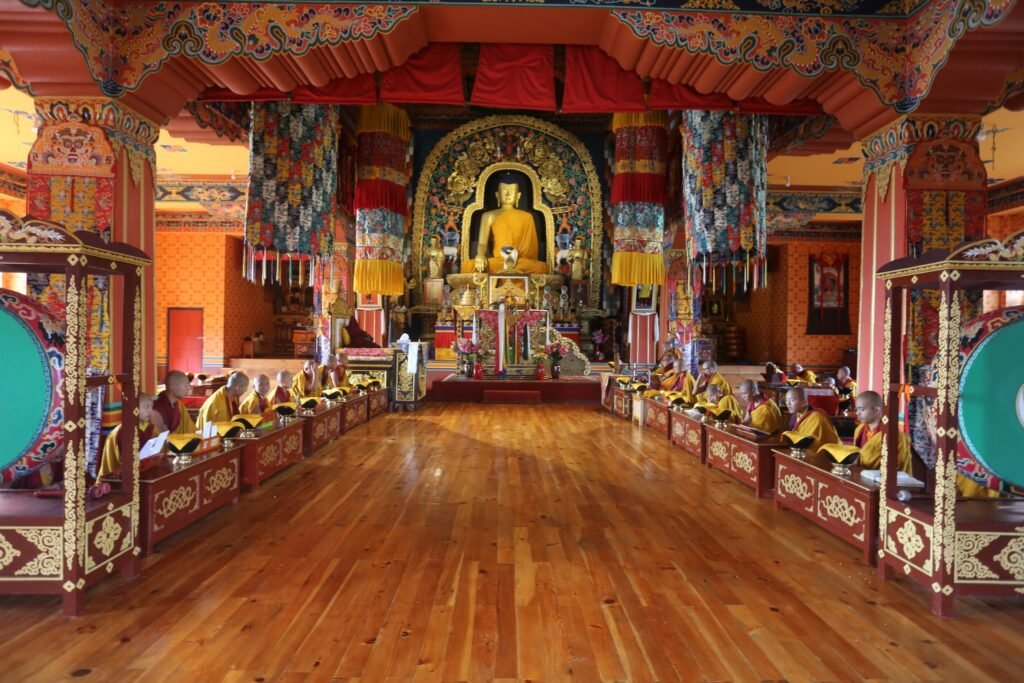Nam Son Pagoda: The Serene Haven of Mahayana Harmony
As sunrise bathes Đà Nẵng’s Hoa Chau Commune, Nam Son Pagoda awakens, its sprawling 10,000-square-meter complex aglow, where the gilded Shakyamuni Buddha statue radiates calm in the main hall. The air hums with Amitabha chanting, devotees seeking rebirth in Amitabha’s Western Paradise, their voices mingling with lotus-scented breezes and the ripple of fish ponds. A long bridge arches over tranquil waters, reflecting the Vong Nguyet Pavilion’s elegant silhouette, a masterpiece of Vietnamese artistry. This Mahayana sanctuary, a gem of the Khất Sĩ sect, invites all to immerse in Vietnam’s vibrant Buddhist heritage.
Overview and Significance
Introduction to Nam Son Pagoda
Nam Son Pagoda, nestled in Hoa Chau Commune, Hoa Vang District, stands as one of Đà Nẵng’s largest Mahayana Buddhist temples, its revered statues of Shakyamuni Buddha and Avalokitesvara embodying the harmony of the Pure Land tradition, which centers on devotion to Amitabha Buddha for rebirth in his Western Paradise. Located 15 minutes from the city center, this 1962-founded retreat blends East Asian elegance with Vietnamese architectural designs, offering serenity amid lush gardens and ponds. Its expansive main hall, photogenic bridges, and vibrant rituals make it a cultural haven, drawing pilgrims, photographers, and spiritual seekers into a realm of tranquility.
Historical Journey
Founded in 1962 by Buddhist devotee Nguyen Van Chau, Nam Son Pagoda emerged as a spiritual retreat for Đà Nẵng’s growing Mahayana community, under the guidance of the Khất Sĩ sect. Built with community donations on a 10,000-square-meter plot, it was designed to embody feng shui harmony, with ponds and bridges fostering balance. Over decades, expansions added the Vong Nguyet Pavilion and meditation halls, funded by local devotees, cementing its status as a modern pilgrimage site.
Through Đà Nẵng’s urban growth, the pagoda has remained a serene escape, its history reflecting the Khất Sĩ sect’s commitment to mindfulness and compassion.
- Patronage: Supported by local Mahayana Buddhists and Khất Sĩ sect.
- Milestones: Founded in 1962; expanded with Vong Nguyet Pavilion in later decades.
Cultural Significance
Nam Son Pagoda is a vital hub for Đà Nẵng’s Mahayana community, nurturing devotion to Shakyamuni Buddha and Avalokitesvara. Its Pure Land practices, centered on Amitabha chanting, offer solace to urban devotees seeking peace. The pagoda hosts cultural events, like Vu Lan festivals and sutra recitations before its statues, preserving Khất Sĩ traditions.
Regionally, it connects with Mahayana communities in Vietnam, sharing Pure Land teachings. Globally, it attracts travelers drawn to its Instagram-worthy design and scholars studying Vietnam’s modern Buddhist architecture, offering a glimpse into Mahayana’s compassion.
- Mahayana Hub: Preserves Pure Land practices for the Khất Sĩ sect.
- Cultural Role: Hosts Vu Lan festivals and sutra recitations.
- Global Appeal: Attracts travelers and scholars for its design and serenity.
Unique Legacy
The pagoda’s Vong Nguyet Pavilion and sacred Shakyamuni Buddha statue define its legacy, embodying Mahayana’s harmony. The pavilion’s graceful arches over fish ponds and the statue’s golden radiance symbolize enlightenment’s balance. Vietnamese lotus motifs and garden designs reflect Khất Sĩ sect syncretism, while statues like Avalokitesvara anchor spiritual devotion.
This fusion of modern architecture, spiritual statues, and natural beauty earns Nam Son Pagoda its title as the “Serene Haven of Mahayana Harmony,” a modern beacon of faith.
- Vong Nguyet Pavilion: Iconic bridge over fish ponds.
- Sacred Statues: Shakyamuni and Avalokitesvara as spiritual anchors.
- Cultural Syncretism: Vietnamese Khất Sĩ influences.
Community and Global Impact
Nam Son Pagoda thrives as a communal heart for Hoa Vang’s Buddhist community. On lunar days, devotees gather before the Shakyamuni Buddha statue to chant and offer incense, their prayers resonating through the gardens. Charity drives, supporting local farmers, strengthen community bonds, while Vu Lan festivals draw crowds with offerings to Avalokitesvara, honoring filial piety.
Globally, the pagoda attracts spiritual tourists and photographers captivated by its serene design. The Vietnamese diaspora supports expansions, reinforcing cultural ties. Its photogenic bridges and spiritual statues cement its global role as a Mahayana retreat.
- Local Engagement: Hosts prayers, charity, and festivals.
- Global Reach: Draws tourists and photographers worldwide.
- Diaspora Support: Funded by Vietnamese communities abroad.
Architectural and Spiritual Features
Iconic Design
Nam Son Pagoda’s architecture blends Mahayana serenity with Vietnamese elegance, its 10,000-square-meter complex centered on the main hall, Vong Nguyet Pavilion, and lush courtyard, framed by lotus ponds and bonsai gardens. Its vibrant palette—gold, red, and green—celebrates Mahayana’s divine calm, with Vietnamese tiled roofs and lotus motifs creating a serene escape from Đà Nẵng’s urban bustle.
The pavilion’s arched bridges and the main hall’s sturdy pillars, rooted in Khất Sĩ sect traditions, craft a sacred oasis of devotion and awe.
- Vong Nguyet Pavilion: Iconic bridge over fish ponds.
- Vietnamese Aesthetic: Tiled roofs and lotus motifs.
- Garden Oasis: Contrasts with Đà Nẵng’s urban sprawl.
Key Structures
The main hall, housing revered statues, is the pagoda’s spiritual heart, its ornate altars glowing under soft light. The Vong Nguyet Pavilion, a graceful structure over a fish pond, connects to meditation halls via long bridges, symbolizing balance. The courtyard, with lotus ponds and bodhi trees, serves as a communal space. Smaller shrines, adorned with ceramic tiles, dot the grounds, while a three-story meditation tower offers quiet reflection.
These structures, harmonizing spiritual and architectural beauty, create a serene Mahayana sanctuary.
- Main Hall: Spiritual heart with revered statues.
- Vong Nguyet Pavilion: Bridge over fish pond.
- Courtyard: Communal space with lotus ponds.
Worshipped Statues
The main hall’s Shakyamuni Buddha statue, gilded and seated on a lotus pedestal, radiates enlightenment, its serene gaze anchoring worship. Avalokitesvara (Quan Thế Âm [觀世音]), crafted in white porcelain with a nectar vase, stands nearby, offering compassion. Maitreya, in gold leaf with a joyful smile, symbolizes future prosperity. Smaller shrines house Mahasthamaprapta, in bronze with a lotus, embodying wisdom, and Ksitigarbha, in jade with a staff, guiding souls from suffering.
These statues, central to Mahayana worship, embody the pagoda’s spiritual essence, their iconography fostering devotion.
- Shakyamuni Buddha: Gilded, symbolizing enlightenment.
- Avalokitesvara: Porcelain, offering compassion.
- Maitreya: Gold leaf, symbolizing prosperity.
Materials and Techniques
The Vong Nguyet Pavilion, crafted with polished granite and ceramic tiles, showcases Vietnamese artisans’ mastery, its arches reflecting Khất Sĩ sect elegance. The main hall’s statues, gilded and carved with lotus motifs, use teak woodwork rooted in local traditions. Stone carvings of Buddhist tales adorn the courtyard, blending Vietnamese craftsmanship with Mahayana symbolism. The tiled roofs, with dragon patterns, add durability and grace, a hallmark of modern Vietnamese architecture.
These materials, grounded in Vietnamese syncretism, create a visually stunning and spiritually resonant sanctuary.
- Granite Pavilion: Ceramic-tiled Vong Nguyet structure.
- Gilded Statues: Teak woodwork with lotus motifs.
- Stone Carvings: Vietnamese Buddhist tales.
Signature Elements
The Vong Nguyet Pavilion and Shakyamuni Buddha statue are the pagoda’s signature elements, their elegance symbolizing Mahayana harmony. The pavilion’s bridges, arching over fish ponds, glow under festival lights, while the statue’s golden serenity anchors worship. Vietnamese altars, with red and gold carvings, frame the statues, enhancing their spiritual presence.
These elements, blending architectural and spiritual significance, define Nam Son Pagoda’s Mahayana identity, captivating all who visit.
- Vong Nguyet Pavilion: Arched bridge symbolizing balance.
- Shakyamuni Statue: Golden anchor of devotion.
- Vietnamese Altars: Vibrant frames for statue worship.
Lesser-Known Features
The main hall’s ceiling, painted with lotus murals, forms a meditative canopy, often unnoticed in soft light. The courtyard’s stone lanterns, inspired by Vietnamese designs, cast gentle glows at dusk. Smaller shrines house ceramic sutra tablets, offering spiritual insight. A koi pond near the meditation tower, with lotus blooms, adds serene beauty, reflecting the pagoda’s tranquil depth.
These subtle details enrich Nam Son’s spiritual allure, rewarding attentive visitors.
- Lotus Murals: Meditative ceiling in the main hall.
- Stone Lanterns: Vietnamese-style courtyard glow.
- Koi Pond: Serene feature near meditation tower.
Preservation and Evolution
The pagoda’s granite structures withstand Đà Nẵng’s humidity, but the pavilion’s tiles require periodic cleaning by artisans. Volunteers maintain the courtyard, shrines, and statue altars. Expansions since 1962 added the Vong Nguyet Pavilion and meditation tower, enhancing accessibility and grandeur.
These efforts ensure Nam Son Pagoda remains a vibrant Mahayana sanctuary, balancing tradition with modernity.
- Maintenance: Periodic tile cleaning.
- Modern Updates: Vong Nguyet Pavilion and meditation tower additions.
Rituals and Practices
Daily Sacred Rites
Each morning, Nam Son Pagoda resonates with Amitabha chanting, led by monks before the Shakyamuni Buddha statue, invoking rebirth in the Western Paradise. Devotees offer incense at the incense house, their prayers rising before Avalokitesvara’s compassionate gaze. The meditation tower’s bell tolls, grounding worshippers in devotion.
Lay followers present lotus flowers and candles to Bodhisattva statues, bowing in reverence. The courtyard ponds invite sutra recitation, fostering Mahayana’s universal salvation.
- Morning Chanting: Amitabha chanting before statues.
- Incense Offerings: Prayers for rebirth in the Pure Land.
- Sutra Recitation: Quiet pond-side devotion.
Unique Practices
The pagoda’s Pure Land devotion centers on Amitabha chanting, guiding devotees toward rebirth in the Western Paradise. Monks lead daily sessions before the Avalokitesvara statue, cultivating mindfulness. Vegetarian offerings, placed in ornate bowls before Shakyamuni Buddha, emphasize merit-making, reflecting Khất Sĩ sect traditions.
On full-moon days, monks perform bridge-walking ceremonies, circling the Vong Nguyet Pavilion while chanting, a Khất Sĩ ritual unique to Nam Son, symbolizing balance and unity.
- Pure Land Chanting: Daily Amitabha sessions.
- Vegetarian Offerings: Merit-making before statues.
- Bridge-Walking Ceremonies: Full-moon Khất Sĩ rituals.
Festival Traditions
Vu Lan, honoring filial piety, transforms Nam Son with devotees pinning roses—red for living parents, white for the deceased—before Avalokitesvara’s statue. Lantern processions light the courtyard, their glow reflecting on lotus ponds, as monks chant for ancestral liberation. Vesak, celebrating Buddha’s life, draws crowds with offerings to Shakyamuni Buddha and dragon dances. Tet brings red envelope offerings, blending Mahayana devotion with Vietnamese festivity.
Lunar days attract pilgrims for special Amitabha chanting sessions, with statue veneration, uniting the community in reverence.
- Vu Lan: Rose-pinning and lantern processions before Avalokitesvara.
- Vesak: Offerings and dragon dances for Buddha’s life.
- Lunar Days: Chanting sessions with statue veneration.
Visitor Engagement
Visitors can light incense or offer lotus flowers before Avalokitesvara at the incense house, guided by monks on Mahayana etiquette. Amitabha chanting sessions, open to all, allow participation in Pure Land practices. During Vu Lan, tourists may pin roses or light lanterns before the statues, immersed in filial piety rituals.
The pagoda’s serene ponds foster cultural exchange, with monks sharing insights on statue worship, connecting locals and global visitors.
- Incense Lighting: Guided offerings before Avalokitesvara.
- Amitabha Chanting: Open Pure Land sessions.
- Festival Participation: Rose-pinning during Vu Lan.
Spiritual Community Roles
Nam Son’s monks, trained in Khất Sĩ Pure Land teachings, lead chanting sessions and mentor devotees. They organize charity drives, supporting Hoa Vang farmers, strengthening community ties. Lay volunteers maintain statue altars and pond walkways, fostering a sense of unity.
The abbot delivers sermons on compassion before Avalokitesvara, guiding initiatives. Buddhist devotee groups organize Vu Lan and Vesak events, enriching communal life.
- Monks: Lead rituals, mentor, and organize charity.
- Lay Volunteers: Maintain statue altars and walkways.
- Buddhist Devotees: Organize Vu Lan and Vesak celebrations.
Visitor Information
Navigating to Nam Son Pagoda
Nam Son Pagoda is located at Cẩm Nam, Hoa Chau Commune, Hoa Vang District, Đà Nẵng, its Vong Nguyet Pavilion a landmark amidst lush gardens. The nearby Marble Mountains, a 15-minute drive, offer scenic caves, while Đà Nẵng’s city center, with landmarks like the Dragon Bridge, is a 25-minute taxi ride. The pagoda blends rural serenity with urban accessibility.
From the city center, visitors can take a taxi or motorbike via Quốc lộ 14B and Nguyễn Tất Thành roads, following signs to Hoa Chau, reaching the pagoda’s tranquil grounds.
- Landmark: Vong Nguyet Pavilion in Hoa Chau.
- Nearby Sites: Marble Mountains (10 km), Dragon Bridge (15 km).
- Central Access: 25-minute taxi from city center.
Address of Nam Son Pagoda
- Vietnamese: Chùa Nam Sơn, Cẩm Nam, Xã Hòa Châu, Huyện Hòa Vang, Thành phố Đà Nẵng, Việt Nam.
- English: Nam Son Pagoda, Cẩm Nam, Hoa Chau Commune, Hoa Vang District, Đà Nẵng City, Vietnam.
Visiting Hours and Etiquette
Nam Son Pagoda is open daily from 6:00 AM to 8:00 PM, with early mornings offering a peaceful setting for chanting before the statues. The main hall and Vong Nguyet Pavilion are accessible daily, with guided tours during festivals like Vu Lan. Visitors should plan 1–2 hours to explore the complex and ponds.
Dress modestly, covering shoulders and knees, and remove shoes before entering the main hall or meditation tower. Photography is permitted in the courtyard but requires permission inside shrines. Bow three times before statues to show respect, adhering to Mahayana customs.
- Hours: 6:00 AM–8:00 PM daily.
- Access: Main hall and pavilion open daily; guided during festivals.
- Etiquette: Modest dress, remove shoes, bow before statues.
Accessibility and Safety
The pagoda offers flat pathways to the courtyard and main hall, suitable for wheelchairs, but steps to the meditation tower may limit access. The pond bridges have handrails, and volunteers assist during festivals, guiding visitors to statue altars. The spacious grounds accommodate mobility-impaired guests.
Hoa Vang is safe, but rural paths may be uneven—wear comfortable shoes. Stay on designated walkways, and bring water for Đà Nẵng’s humidity.
- Accessibility: Flat pathways; steps to meditation tower.
- Safety: Wear comfortable shoes; stay on walkways.
- Assistance: Volunteers available during festivals.
Amenities and Surroundings
Nam Son Pagoda provides restrooms, drinking water, and shaded benches in the courtyard. A kiosk sells incense and lotus flowers for statue offerings, supporting maintenance. The lotus ponds and koi fish create tranquil spots, enhancing the spiritual ambiance.
Hoa Chau offers local phở stalls, while the nearby Marble Mountains provide stone carving shops and Non Nuoc Beach dining, enriching the cultural experience without overshadowing the pagoda’s serenity.
- Amenities: Restrooms, water, incense kiosk.
- Surroundings: Phở stalls, Marble Mountains (10 km).
- Sensory Highlights: Lotus scents, pond ripples, garden calm.
Immersive Visitor Tips
Arrive at 6:00 AM to join Amitabha chanting before the Shakyamuni Buddha statue, fostering mindfulness. During Vu Lan, offer a rose before Avalokitesvara and light a lantern, immersing in filial piety rituals. Photograph the Vong Nguyet Pavilion at sunrise, its arches glowing over the pond, but avoid flash in shrines.
Visit the Marble Mountains post-visit for cave exploration, or dine at Non Nuoc Beach for seafood. Attend on lunar days for bridge-walking ceremonies and statue veneration, deepening your connection.
- Morning Chanting: Join Amitabha sessions early.
- Sunrise Photography: Capture the pavilion’s arches.
- Festival Immersion: Offer roses during Vu Lan.
